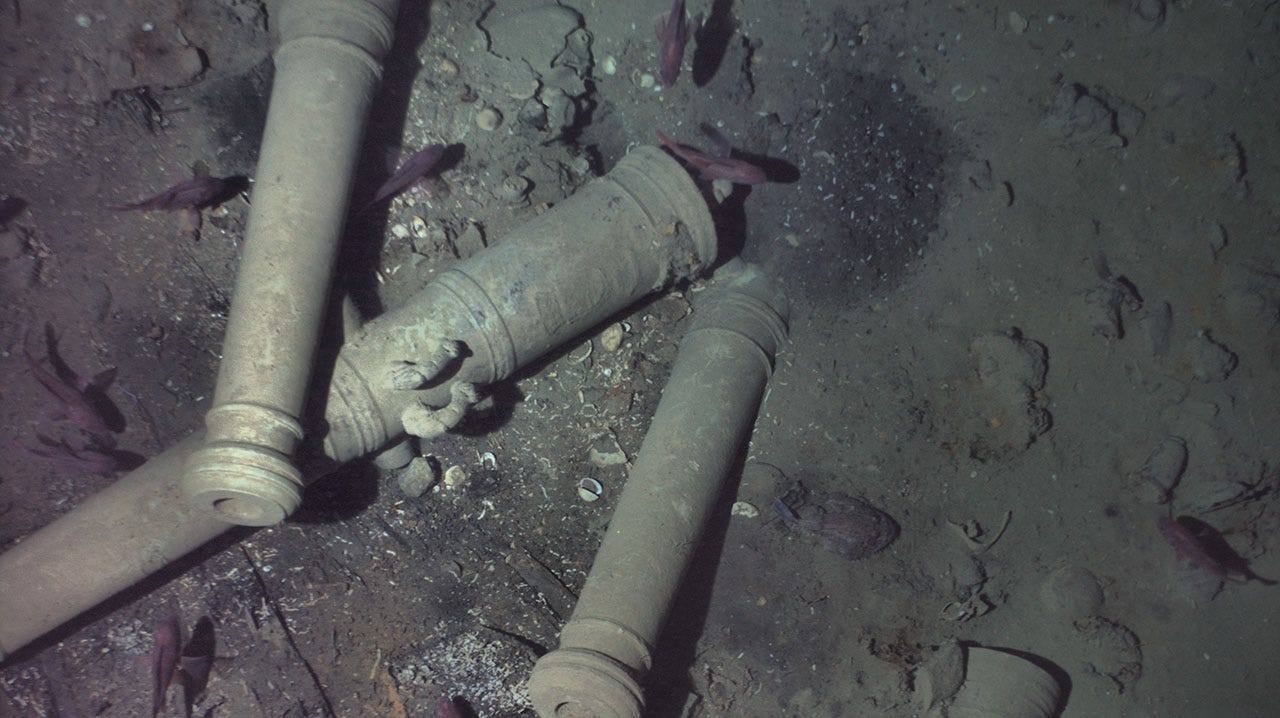Meet REMUS, the robot that discovered $17 billion in sunken treasure


To confirm the wreck's identity, REMUS descended to just 30 feet above the wreck where it was able to capture photos of a key distinguishing feature of the San José -- its cannons. (REMUS image, Woods Hole Oceanographic Institution)
Bombarded by politics, data concerns, and the normal hysterics of the always-on news cycle, we occasionally need an old fashioned story about sunken treasure.
This is a good one, though it's anything but old fashioned.
It starts in the turbulent days of the early 18th century. On June 8, 1708, the San Jose, one of the largest treasure galleons in the Spanish fleet, encountered British ships. It was the height of the War of Spanish Succession, and a maritime battle ensued.
TechRepublic: 2,000 year old 'computer' discovered: How tech and shipwrecks are rewriting human history
The San Jose stood a good chance with its 62 canons and a crew trained to protect its valuable cargo of loot from the New World. But fate was not on San Jose's side. A store of gunpowder aboard the ship ignited during the battle, sending 600 souls and a haul of gold, silver, and emeralds mined in Peru to the murky depths.
The treasure was valued at $17 billion in today's dollars. Naturally, the wreck has been one of the most coveted unicorns for maritime treasure seekers ever since.
It was found two years ago, and we only just learned that it took a robot to do it.
REMUS 6000 is the latest in a series of underwater research robots from Woods Hole Oceanographic Institute (WHOI) in Massachusetts, the largest independent nonprofit dedicated to ocean research in the world.
REMUS 6000 being deployed off the Colombian Navy research ship ARC Malpelo.
(Mike Purcell, Woods Hole Oceanographic Institution)
The torpedo-shaped submersible is capable of operating at depths up to 3.73 miles. It weighs 1,900 pounds on the hard and measures 12.6 feet tip to stern.
An autonomous explorer, it navigates its punishing environment like a fantasy creature perfectly suited to the depths. GPS and radio signals become useless far below the surface, so engineers had to get creative.
The robot uses accelerometers and gyros to measure movement in three directions (surge, sway, heave), and three rotations (roll, pitch, yaw). These measurements enable it to fix velocity and travel distance, a kind of computer-aided dead reckoning.
It also uses pulses of sound, which it bounces off the bottom to determine altitude. Separate sonar pulses sent in the direction of travel help the robot avoid obstacles.
On the surface, operators can communicate mission commands and get updates via short pulses of sound, which function like data-rich morse code.
To survive the crushing pressure, the robot is built around a titanium spine. Its body is a kind of nearly indestructible yellow foam that's impenetrable to water and won't crush, even at a depth of four miles.
The REMUS line of autonomous underwater vehicles (AUVs) was designed at Woods Hole to be a low cost research and monitoring submersible (REMUS stands for Remote Environmental Monitoring UnitS). It can be deployed quickly and operated with little more than a laptop.
Cheap, easily-deployed drones are a major trend in environmental research. Consumer interest has brought prices of unmanned aerial vehicles down dramatically in the last couple years. Enthusiasm in the world of environmental science has done the same thing for submersibles, which now allow researchers with relatively paltry budgets access to places humans have never peered.
Also: This swarm of robot submersibles can be controlled as a single entity
WHOI's REMUS line is customizable and task-agnostic. It's immensely robust and versatile, making it a favorite for a variety of different organizations.
Aside from regular duty doing research around the world, REMUS saw action in Iraqi Freedom when the U.S. Navy used it to look for mines in the Persian Gulf. It was also used to find the remains of Air France 447 when it crashed off the coast of Brazil a decade ago.
The discovery of the San Jose off the coast of Cartagena, Colombia, actually occurred two years ago, but details of the historic find have emerged slowly amid controversy over patrimony and ownership.
Tea cups from the San Jose strewn (but mostly unbroken) on the sea floor.
The Colombian military deployed the REMUS 6000 that located the wreck. The search team consisted of international scientists and engineers and experts from WHOI, Maritime Archaeology Consultants, Switzerland AG, and the Colombian government.
The wreck was found after a meticulous grid search of a large area where the wreck was likely to lay. REMUS's side-sonar picked up the first traces of a sunken ship.
"The REMUS 6000 was the ideal tool for the job, since it's capable of conducting long-duration missions over wide areas," said WHOI engineer and expedition leader Mike Purcell.
Shipboard, engineers knew they'd found the wreck based on images of the San Jose's distinctive cannons, which the robot pinged back to the surface.
For now, the exact coordinates of the treasure remain a closely guarded secret.